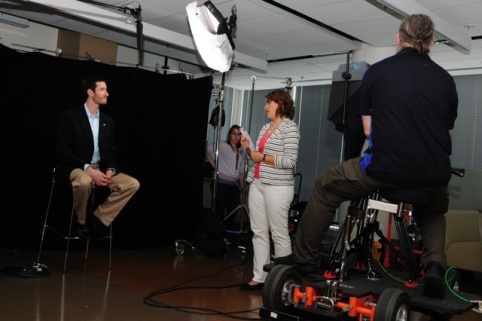 So-called “real people” can add power to a video story. For testimonials, someone who actually uses the product can be compelling. If the story focuses on a charity, someone who has lived the day-to-day impact can help raise funds more effectively than an on-camera professional host. A person who works in an organization might be the very best at explaining a new process or tool.
So-called “real people” can add power to a video story. For testimonials, someone who actually uses the product can be compelling. If the story focuses on a charity, someone who has lived the day-to-day impact can help raise funds more effectively than an on-camera professional host. A person who works in an organization might be the very best at explaining a new process or tool.
But here’s the catch.
Using real people as opposed to actors affects the bottom line costs of your video, in both production and post. Often executive producers focus on the cost-savings of not having to hire actors–no actor fees, no casting fees, no pension and welfare payments (for union actors). However, pro’s bring their ability to hit their marks every time, to become characters convincingly, and to deliver a particular line the same way in the wide shot, the closeup and the shot that gets done after a lunch break.
So if you are using real people, you need to focus on 3 areas to minimize the budget negatives:
- Casting. While you may use an informal process, you’ll still need to “cast” people to be sure they can work with you, they have an interesting story, and to build a relationship prior to the day of taping. While actors can step onto a set filled with strangers and go, most regular folks can’t. Always avoid using someone solely on the recommendation on another person. If you will be the day-of-production interviewer, producer or director, you’ll need to talk to them yourself to be sure you have a good rapport.
- Scheduling. Build extra time into your shoot schedule. Not just for each angle or shot, but also breaks for your “talent.” Unlike pro’s, who can muscle through a long day, most regular folks need some time out of the lights. Plus they will likely need to make calls, check on the kids being picked up from soccer, etc. I’m always surprised how often I’ve got someone telling me they’ve “blocked out” the whole day for our shoot, and then when we arrive, they’ve actually got several hours of phone calls, errands or other work scheduled. No one outside of production understands that what we do is a really focused, full day or more type of job.
- Post Workflow. Your post-production workflow will also need to be adjusted. If you are conducting interviews, be sure you get transcripts made (from mp3 or wav files of the interviews) so that you can make a preliminary set of selects and then choose from those for your final edits. This will save massive amounts of time slogging through footage to find soundbites. If you are creating a re-enactment or a direct-to-camera video, you’ll need excellent field notes via Adobe Live Logger, Google docs, Lumberjack, etc. that allows you to correct for the usual mistakes and changed dialogue or non-matching action that commonly occur when using non-actors. Again, this will save massive amounts of time and frustration during editing.
I’ve built some handy templates and other prep, shoot and post resources into my new book The Producer’s Playbook: Real People on Camera. Use code FLR40 at checkout for 20% off (not available on Amazon). Let me know any other tools you think I should add here on the website.

 It’s been a cold, rainy spring here in DC, the perfect weather for planning and strategy (not so great for outdoor shoots). And post-NAB Show, it’s a great time to re-assess workflows, consider new technologies, and tidy up that digital media library.
It’s been a cold, rainy spring here in DC, the perfect weather for planning and strategy (not so great for outdoor shoots). And post-NAB Show, it’s a great time to re-assess workflows, consider new technologies, and tidy up that digital media library. eelancers in the creative disciplines—graphic design, video, set design, etc.—we’ve got a lot on our plates. Every day we’ve got to be, well, creative out-of-the-box thinkers, able to leap small budgets in a single bound, staying on the bleeding edge of trends, and up on the latest hardware, software and teams that make it all possible. Plus we’ve got to run our businesses, paying our bills, invoicing our clients, and thinking strategically about our careers and where we want to go next. It’s a tall order. Here are some ways we can break it down and get it done.
eelancers in the creative disciplines—graphic design, video, set design, etc.—we’ve got a lot on our plates. Every day we’ve got to be, well, creative out-of-the-box thinkers, able to leap small budgets in a single bound, staying on the bleeding edge of trends, and up on the latest hardware, software and teams that make it all possible. Plus we’ve got to run our businesses, paying our bills, invoicing our clients, and thinking strategically about our careers and where we want to go next. It’s a tall order. Here are some ways we can break it down and get it done.


